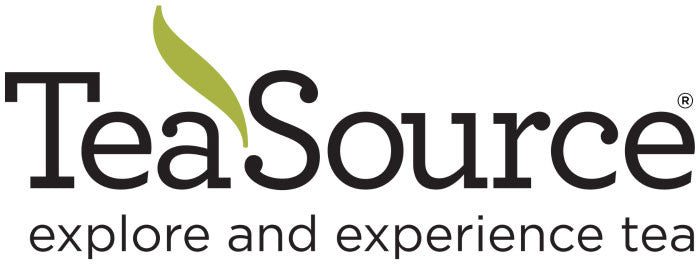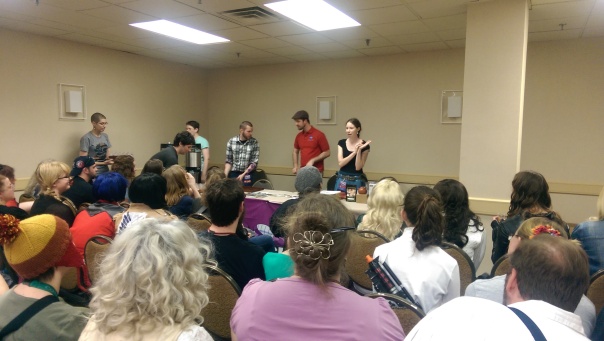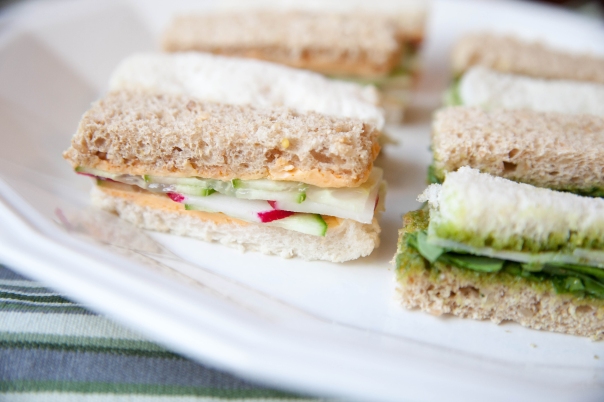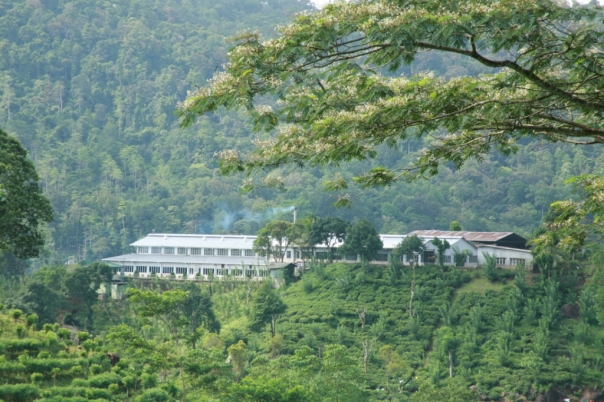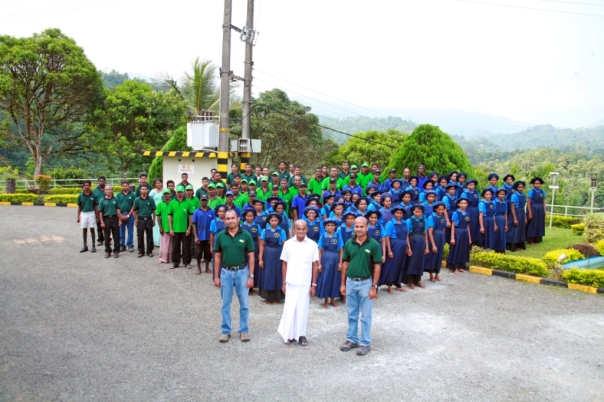-
Dark tea is unique because it is the only deliberately aged tea that undergoes a secondary fermentation process. Because of this additional step, it contains an active micro-organism called Golden Flowers (Eurotium Cristatum). This micro-organism is present specifically in Dark tea made in Anhua County, Hunan Province, China. Golden Flowers is actually visible in some Dark teas and looks like tiny yellow flecks. If you want to experience Golden Flowers up close and personal, check out our Fu Cha brick.
Puer, which is a sub-category of Dark tea, contains a different micro-organism called Asper Nigellus. This is due to variation in growing conditions, soil, and geography. Golden Flowers is a relatively new discovery, having just been identified in the last 30 years. To this day, the process of making Dark tea is a closely guarded secret. Here are some quick facts about Anhua Dark tea for all you biochemistry buffs out there:- Significant polyphenol content
- Significant L-Theanine content
- Significant thearubigin & theaflavin content
- Significant polysaccharide compounds
Dark tea is a critical source of minerals and nutrients to people in many areas of China. Over the past several years TeaSource has had the opportunity to work with Ms. Zhang Liumei, tea scientist and co-founder of Yiqingyuan Tea company in Hunan Province. Ms. Zhang created one of our most popular and unique teas, Dark Rose, which is pressed into a small heart shape. She describes it as “a spa in a cup” and she’s right. It’s a perfect introduction to this fascinating category of tea.
-
CON was very fun this year, lots of good costumes, theme rooms, and theme cocktails! TeaSource provided tea for the convention and I gave a Geek Tea Presentation. We had 100 people in the room, but there were another 50+ outside that wanted to get in. (We brought them tea samples!) People asked lots of great questions, took home some fantastic prizes, and sipped some great classic British-style blends.
Geek Tea Presentation and Tasting
Here is a list of the teas we tried and the ones we gave away loose leaf samples of.
Teas we sipped:
East India Blend- For Arthur Dent From Hitchhiker’s Guide to the Galaxy (because he references the E. India Co.)
Scottish Breakfast- For the 10th Doctor from Doctor Who (because David Tenant is Scottish and also the best Dr.)
Lapsang Souchong- For Sherlock Holmes (because it’s the best tea for Brilliant deductions)Teas we gave out samples of:
TeaSource Spice- For Jessica from Dune (The Spice must flow!) (P.S. I am named after this character and will probably dress up as her for next year’s CON! Does anyone have a stillsuit I can borrow?)
Pi Lo Chun, Supreme- For Princess Leia from Star Wars (because the leaf is curled up into a little ball- like her hair)
Milk Oolong- For Princess Buttercup from the Princess Bride (Milk…butter…yup)
Green Dragon Oolong- For Danerys Targarian from Game of Thrones (She has Dragons and one is green)
Strong Assam- For Professor Snape from Harry Potter (because Prof. Snape is awesome…assam)
Earl Grey White Tip- For Captain Jean luc Picard from Star Trek (Earl Grey, Hot…tea of the 24th century)
White Tip Silver Needles- For Galadriel from The Lord of the Rings (elegant, floral, silver, just like a she-elf)Me and a loyal TeaSource customer, Nick
Can't wait for next year's event!
Until then,
Jess Hanley
TeaSource Manager -
Short History
It is said the Zen priest Eisai (pictured right) brought tea seeds to Kyoto in 1191 and popularized the consumption of powdered tea. It wasn’t until the fifteenth century that a new culture around tea evolved into the modern tea ceremony known as Chanoyu (literally translated “hot water for tea”). The tea ceremony is an extremely structured and studied ritual that embodies many philosophical, artistic, and aesthetic concepts unique to Japanese culture.Uses For Matcha
Traditionally, a powdered green tea called matcha is used during the tea ceremony, along with an array of traditional utensils. Matcha can also be prepared casually and is often used in recipes for ice cream, chocolate, and smoothies. The tea ceremony is just one way to appreciate the act of making and serving matcha, but it is by no means the only way.Production
Matcha is made from the tea leaves similar to those grown to make Gyokuro, a high grade tea that is shaded for the last three weeks before plucking. The shading causes the plant to produce more chlorophyll, giving both the leaf and the liquor a brilliant emerald color. These leaves are then stone ground into a powder to make matcha. High grade matcha steeps up sweet and slightly bitter with a taste of the sea. Japanese teas are distinct for three main reasons: they are machine harvested, they are often shaded before plucking (though not always), and they are steamed instead of fired.How Do I Make Matcha?
It is not difficult to make matcha at home using the traditional utensils. In fact, it affords an opportunity to develop a ritual of your own. You do not have to be a tea master to enjoy preparing matcha.
Supplies
Here’s what you’ll need to get started.
-Bamboo tea scoop
-Tea bowl
-Bamboo tea whisk
-Small strainer
-Ceremonial grade matchaDirections
- Heat the tea bowl with a small amount of hot water, the same way you would warm a teapot.
- Using a bamboo scoop, measure two heaping scoops (0.75 grams) into your tea bowl. (NOTE: It is important to sift the matcha through a strainer to remove any clumps.)
- Heat your water to a rolling boil and add a small amount of cold water to bring the temperature down to 175 – 185 degrees.
- Measure approximately ¼ cup of water and pour it into the bowl.
- Whisk the matcha vigorously for 15-20 seconds. Small bubbles will start to appear on the top of the liquid. TIP: The whisking action comes from the wrist; your arm should not move at all. Make “M” or “W” shapes with the whisk, careful not to let it touch the bottom of the bowl. This will fully aerate the tea as it dissolves.
“Yet what is truly amazing is that nothing special or extraordinary takes place. The host and guests simply engage in the act of making and drinking tea. But it is this act that is important, for in the smallness of the tea room, the whole universe – heaven, earth, and life itself – can be evoked.” -Yasushi Inoue
-
Spring feels like the perfect time of year to host afternoon tea. The temperatures have risen, the sun shines brighter, gardens and flowers are in bloom, and homes have undergone their yearly spring cleaning. People are out and about, ready to converse and connect again.
A few of us at TeaSource had the pleasure of spending a day together planning an afternoon tea of our own! We enjoyed preparing food, drinking tea, taking photos, and of course, eating! We wanted to share our recipes and ideas with you so that you could host a party of your own, be it for Mother’s Day, a birthday party, or just because!
Jess Jellings, a former TeaSource employee and cook extraordinaire, is the mastermind behind all of the recipes you see here. THEY ARE DELICIOUS. There isn’t enough space here to gush about her creativity and skills in the kitchen. Gretchen Pruett, our fabulous photographer, captured the beauty and simplicity of the finished products before they disappeared into our mouths. Bon appétit!
Menu
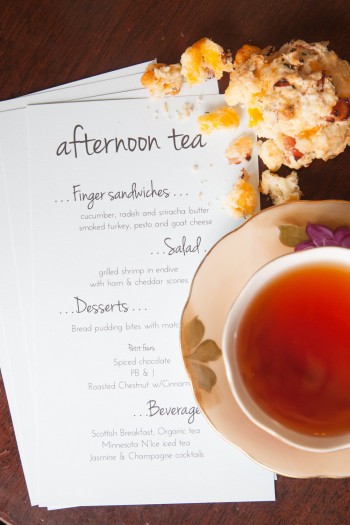
Finger Sandwiches… cucumber, radish, and sriracha butter smoked turkey, pesto, and goat cheese
Salad… grilled shrimp in endive with ham and cheddar scones
Desserts… bread pudding bites with matcha glaze
Petit Fours… spiced chocolate PB & J roasted chestnut with cinnamon
Beverages... Scottish breakfast, organic Minnesota N’Ice iced tea Jasmine & Champagne cocktails
Cucumber, Radish and Sriracha Butter Finger Sandwiches
Makes 1 dozen6 slices bread
1 english cucumber, sliced
3 radishes, thinly sliced
Sriracha butter (see below)Spread a thin layer of butter on each slice of bread. Layer cucumbers and radishes on three slices of bread, top with remaining three slices. Cut the crusts off each sandwich and cut into four finger sandwiches.
For the Sriracha Butter:
1 stick butter, softened
2-3 tablespoons sriracha (depends on your taste)Using a fork or beater, mix the butter and sriracha until well combined. If you have any left over, try it on popcorn, it’s fabulous.
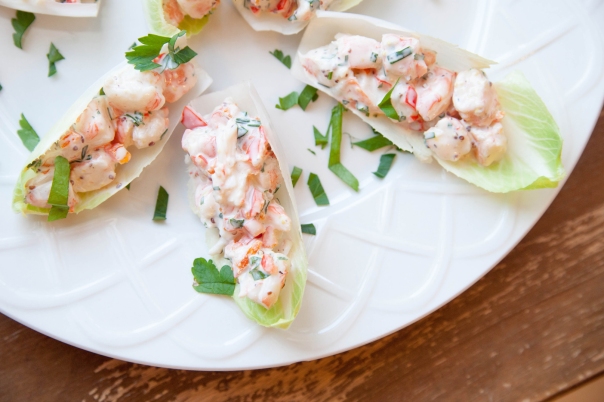
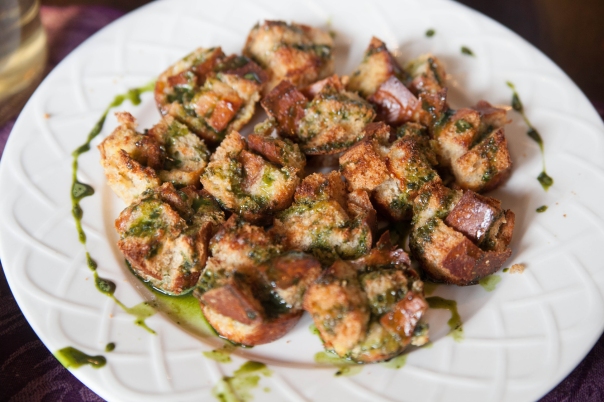
Mini Bread Puddings with Matcha Glaze
Makes 2 dozen minis (or one 9x9 baking dish)1 cup milk
2 eggs
1/3 cup sugar
1 teaspoon vanilla
3 tablespoons melted butter
1 teaspoon cinnamon
¼ teaspoon salt
4 cups bread, cubedGlaze:
¼ cup powdered sugar
1 tablespoon powdered matcha
1-2 tablespoons milkPreheat oven to 350 degrees.
Prepare a 24-mini muffin tin (or 9x9 baking dish) by greasing with butter or non-stick spray. Combine milk, eggs, sugar, vanilla, butter, cinnamon and salt in a medium bowl and whisk to combine. Pour the egg mixture into the mini muffin pan, until each well is about half full (no need to be crazy here, just make sure the egg mixture is evenly distributed). If using a baking dish, add egg mixture to prepared dish. Divide the bread cubes between each well and push down slightly to soak up the egg mixture. Let sit about 30 minutes, pressing occasionally.
If using a baking dish, add the bread and let sit about 30 minutes.Bake for 15-20 minutes until set and golden. Combine the powdered sugar, matcha and 1 tablespoon of milk in a small bowl and stir to combine. You want the glaze to fall in a thick ribbon, add the additional milk, if needed. Drizzle over the bread puddings and serve warm.
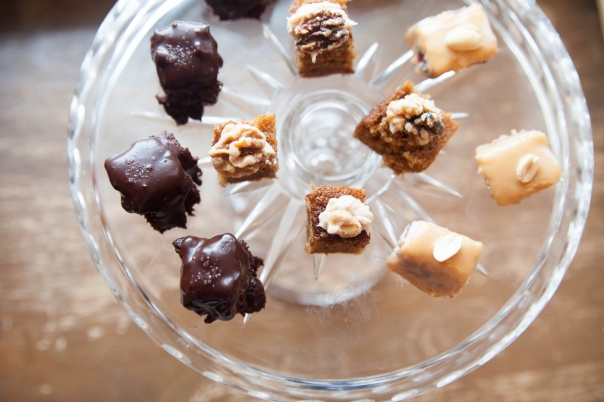
Roasted Chestnut Petit Fours
Makes 4 dozen (or one 9x13 cake, depending on how you wish to serve)
1 ¾ cups all purpose flour
2 cups sugar
¾ cup malted milk powder
1 ½ teaspoons baking soda
1 ½ teaspoons baking powder
1 teaspoon salt
1 ½ teaspoons cinnamon
2 teaspoons Roasted Chestnut Tea, ground fine
2 eggs
1 cup milk
½ cup vegetable oil
2 teaspoons vanilla
1 cup hot Roasted Chestnut Tea, brewed double strength
½ cup roasted walnuts, for garnish
Frosting (recipe below)Preheat oven to 350 degrees. In a large mixing bowl, combine all of the dry ingredients and whisk well to combine. Stir in the eggs, milk, oil and vanilla. Whisk for two minutes until all ingredients are well incorporated. Using a spoon, slowly stir in the hot tea. DO NOT OVERMIX, batter should appear very thin. Pour into an ungreased 9x13 baking dish and bake for 30-40 minutes until a toothpick inserted in the center comes out clean.
If you wanted to make a cake, let cool completely before adding frosting and walnuts. If you want to make petit fours, let the cake cool completely and freeze for 1-2 hours to make it easier to cut into 1x1 squares. Pipe a small floret onto each petit four and top with a walnut half. Chill until ready to serve.
Frosting:
1 stick softened butter
1 teaspoon cinnamon
1 cup powdered sugarMix in a large bowl using an electric mixer, about 2 minutes until fluffy.
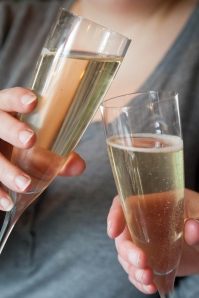
Jasmine & Champagne cocktails
1 part cold brewed Jasmine, chilled
1 part Champagne, chilledFill a champagne flute halfway with Jasmine, then top off the glass with champagne. Adjust to your personal taste. Cheers! Cold brew iced tea instructions here.
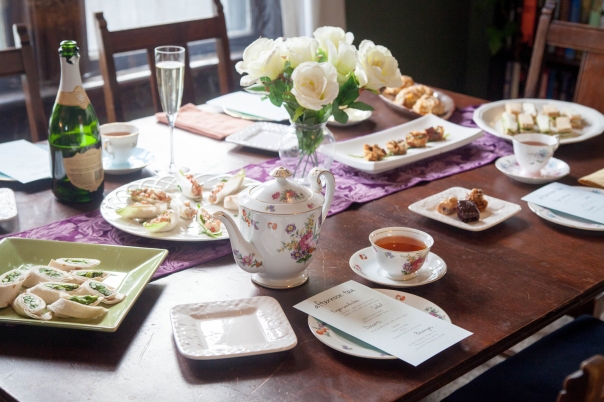
We paired Scottish Breakfast, Organic and Minnesota N’Ice with our afternoon tea. However, a floral green like Cherry Blossom Green, a straight green like Huang Shan Mao Feng, or an herbal such as Scarlet O'Peara would also compliment this spread nicely.
More recipes can also be found here. Enjoy!
-
“I’ve never heard of that kind of tea before.” Bill Waddington
Milk tea being made at the Rohini Estate, Darjeeling, India.
It’s not very often that I say those words. But it happened while I was in India last month. Almost every tea place I stopped in - street stalls, tea broker’s offices, tea gardens - I would be asked if I wanted tea. Of course I would say “yes.” I would be asked if I wanted “black tea” or “milk tea.” And this gave me pause.
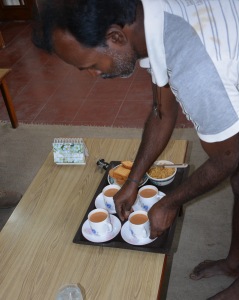
Milk tea being served at the Rohini Estate, Darjeeling.
At first I thought they just meant a black tea served with milk on the side. But it became clear this was not what they meant. “Milk Tea” was a completely different/unique concoction: not black tea, not tea with milk, not “Royal Milk Tea,” not boba or bubble tea, not chai tea (or masala chai). I already knew all of those. Milk tea is its own thing. So of course I asked for it. Then asked for it at the next place, and the next place ... It’s reaalllly good. It is strong, sweet, smooth, milky (duh), and the method of preparation totally took me by surprise. In the interest of full disclosure my wife did not like it, but EVERYONE at TeaSource did.
This is one of the things I most love about tea: almost every culture in the world drinks tea-and almost all of them do something different with it. Tea snobs be damned.
On Thursday, April 17 at Noon (CST) I will be doing a Livestream broadcast, demonstrating how to make Indian Milk Tea. To participate, just click here, log in, then sit back and enjoy!
FYI, we try to do Livestream broadcasts approximately once a month. All are welcome to watch and participate. We announce these on Twitter and Facebook, as well as our monthly email newsletter.
Thanks, -Bill
-
The Lumbini Tea Factory
The tea profession is old. Not the oldest (we all know what that is), but still old. It has been a part of global trade before any of us knew we were “global”. It’s still mostly transported by large boats over vast oceans. And the main preparation method of steeping leaves in boiled water has gone almost unchanged for hundreds of years. It finds its way to market any way it can, and because of this, sometimes you just have to go to the growers directly, even if they’re in Sri Lanka.
For example, here’s a fictionalized email exchange of us buying Ceylon (Sri Lankan) tea: "Hi Chaminda, it’s Bill from TeaSource. We’d like to buy 500 kilograms of the Lumbini Estate FBOP. Do you have it available?" "Hi Bill, it’s Chaminda from the Lumbini Estate. We do have that available for you. We’ll ship it out right away."
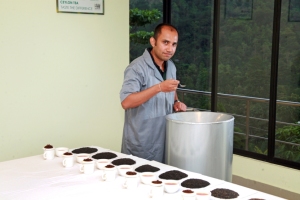
Chaminda Jayawardana doing a tea evaluationAnd as simple as that, a truck shows up around 10-12 weeks later (remember, most of its journey is by boat) with a pallet of tea in wooden chests with the words “Lumbini Tea” stenciled on them. One wire transfer to the Lumbini Estate later and we’ve successfully done business. That is exactly how it happens (with the addition of a lot of unpleasant bureaucracy when crossing international boarders, but let’s keep the story positive).
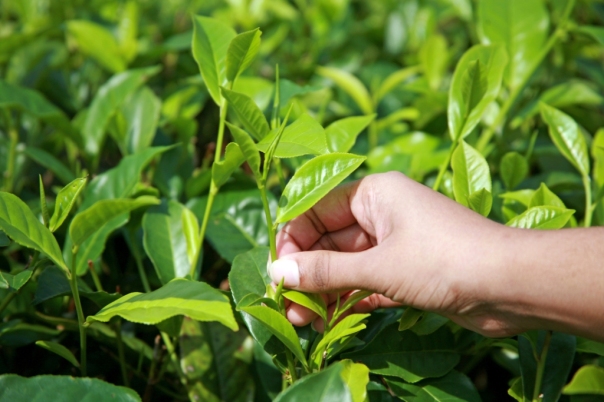
Leaves from the Lumbini tea fieldsTeaSource has been buying tea from Lumbini estate for the last 14 years and they’ve been wonderful partners to work with. It started in 2000 when Bill was on a trip to Sri Lanka and visited their factory.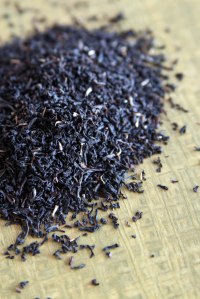
Chaminda had presented an experiment of Ceylon “Silver Needles” to the visitors (a white tea from Sri Lanka is rather controversial to most tea purists) and Bill could not help but discretely make an offer on the spot (Bill said he had to buy extra luggage just to get it home).
Since then, we’ve been regularly buying their FBOP (Flowery Broken Orange Pekoe), and now expanded to their OPA (Orange Pekoe A: a long twisted leaf style), and their “Burning Sun” FBOPF (Flowery Broken Orange Pekoe Fannings: very small leaf style – which TeaSource recently submitted and won 1st place in the North American Tea Championships in their “Breakfast Blend” category).

The founder of the Lumbini Estate, Mr. Dayapala Jayawardane.The Lumbini Estate and factory was started by Mr. Dayapala Jayawardane in 1984. It is located in the mountainous village of Pallegama in southern Sri Lanka. Because of his faith, Mr. Jayawardane named it “Lumbini” in honor of the birthplace of The Buddha. The factory produces almost exclusively black tea – the exception being their Ceylon Silver Needles – approximately 600,000 kg per year! They pride themselves on their skill as both a grower and manufacturer, employing 80 machine operators and 30 tea pluckers. His son, Chaminda Jayawardane, is now the CEO and generously gives his time to his international customers, like TeaSource. It’s a privilege to work so close with someone so far away, and this month we’ll proudly be featuring all our Lumbini teas.
